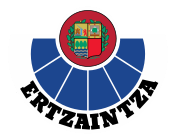Ertzaintza
|
People's Guard Ertzaintza |
|||||
|---|---|---|---|---|---|

Logo of the People's Guard
|
|||||
| Agency overview | |||||
| Formed | 1982 | ||||
| Preceding agency | Ertzaña | ||||
| Annual budget | US$634.34 million (€570 million) (2015) | ||||
| Legal personality | Governmental: Government agency | ||||
| Jurisdictional structure | |||||
| Operations jurisdiction* | Autonomous Community of Basque Country, Spain | ||||
| Governing body | Home Office of the Basque Government | ||||
| Constituting instrument | Statute of Autonomy of the Basque Country | ||||
| General nature | |||||
| Operational structure | |||||
| Headquarters | Erandio, Basque Country | ||||
| Ertzainas | 8,000 | ||||
| Elected officer responsible | Estefanía Beltrán de Heredia, Basque Minister of Security | ||||
| Agency executive | Gervasio Gabirondo , Director | ||||
| Divisions |
List
|
||||
| Police Stations |
List
|
||||
| Facilities | |||||
| Stations | 20 | ||||
| Boats | 1 | ||||
| Helicopters | 3 | ||||
|
|||||
| Website | |||||
| http://www.ertzaintza.net | |||||
| Footnotes | |||||
| * Divisional agency: Division of the country, over which the agency has usual operational jurisdiction. | |||||
| Notables | |
|---|---|
| Anniversaries |
|
The Ertzaintza (Basque: [erts̻aints̻a], English: Public Guard or People's Guard), is the police force for the Basque Country. An Ertzaintza member is called an ertzaina (IPA: [erts̻aɲa]).
The origins of the current Ertzaintza, can be traced back to the old municipal militias, which were popular organizations at the service of local bodies, created to satisfy the need for public safety. But it was not until the 19th century when the almost permanent police corps of a professional nature were created.
It was a response to the banditry caused by the continuous social and political upheaval occurring from the end of the 18th century and well into the 19th. The decisive argument for its configuration was the First Carlist War, when the Miqueletes of Biscay and Guipuzcoa and the Miñones of Alava commenced their activities.
Once the urgencies of the war were overcome, the Spanish government attempted to recover the functions carried out by these regional forces and transfer them to the Civil Guard, which was created in 1844. Nevertheless, due to difficulties encountered when recruiting forces for this corps in the Basque provinces, plus the pressure posed by the other regional Governments, the very same regional forces were able to more or less carry on with their task.
After the end of the Second Carlist War (1876), the Spanish government wished to curtail the regional autonomy. The Basque police forces had to adapt to this new centralist tendency, and these changes mostly manifested themselves in a reduction of personnel & operational capabilities.
When the Second Spanish Republic was proclaimed in 1931, political activity surged and so did the Basque claim to re-establish regional liberties that had been abolished in 1876. Thus, various projects for the Autonomy Statute were promoted.
...
Wikipedia
